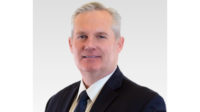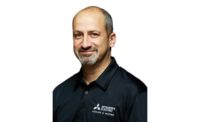Every successful project starts with a framework. A vision statement. A blueprint. The editors of Engineered Systems are proud to present The Blueprint — a monthly Q&A interview with HVACR engineering’s leading voices. These one-on-one discussions will examine the trade’s history, current industry trends, the factors shaping the sector’s future, and more.
Trane® is a global manufacturer of air conditioning systems, services, and solutions. The company helps customers succeed by providing innovative solutions that optimize indoor environments through a broad portfolio of energy-efficient heating, ventilating, and air conditioning systems; building, contracting and energy services; parts support; and advanced controls for homes and commercial buildings.
With more than 900 U.S. patents to date, Trane creates comfortable and energy-efficient environments around the world. Renowned landmarks such as the Moscow Kremlin, New York’s Grand Central Station and the Burj Khalifa tower in Dubai all enjoy the comfort provided by Trane solutions.
Today, the brand that began as a family business over a century ago employs thousands of dedicated women and men around the world.
Recently, Trevor Gensch, VRF/ductless national sales leader based out of New York, sat down with Herb Woerpel to discuss the current state of the company’s VRF offerings; the evolution of the manufacturer’s partnership with Mitsubishi Electric; its new digitally enabled, connected VRF service agreement offering; and more.
To see all of Engineered Systems' Blueprint Q&A interviews, click here.
Engineered Systems: Variable refrigerant flow (VRF) continues to be a growing market in the U.S. Can you share any updated metrics that define the equipment’s role in the U.S. market?
Trevor Gensch: VRF systems are unique in that their modular design allows them to be customized to meet the specific demands of virtually any size building. That flexibility combined with VRF’s superior energy efficiency has resulted in the VRF market within the U.S. continuing to grow and outpace other segments of the HVAC industry. In fact, 21.5% of contractors’ commercial HVAC projects in the U.S. now include VRF Technology. (According to the May 2019 QP: VRF report conducted by Trane’s market insight team.)
Engineered Systems: You’re now 2 ½ years into the joint venture of Trane and Mitsubishi Electric. How has business progressed over that time?
Gensch: The joint venture has been incredibly successful. We have been able to bring together a world leader in VRF product and innovation in Mitsubishi Electric and complement that with the application expertise, broad product line, and full-service support that Trane has delivered for the past 100 years. Together, our teams have been able to offer unique energy efficient solutions to building owners and developers for the entirety of a building’s full life cycle.
Engineered Systems: This joint venture was extremely exciting for the future of VRF in the U.S. Talk specifically about Trane’s current offerings and how the joint venture has impacted those options.
Gensch: The most exciting part of the joint venture is our ability to find creative solutions to our customers’ needs by utilizing the full resources of METUS and Trane. For example, we have been able to pair VRF technology with our legacy air-handling units, and we recently announced that our legacy Trane Tracer® SC+ controls integrate directly with our Trane/Mitsubishi Electric’s N-Generation CITY MULTI® VRF equipment.
Engineered Systems: Please share how and why controls are so important in VRF units.
Gensch: VRF Systems are naturally efficient and have a high level of control. When combined with the increased flexibility of Tracer SC+ controls, building owners can take that efficiency and controllability to the next level. For example, by having a direct connection to the VRF system and a ventilation system, we can create unique programs to operate the building at peak efficiency regardless of changing load conditions or occupancy.
Engineered Systems: I know Trane has been active in spreading VRF awareness — most recently Trane professionals have partnered with Engineered Systems to present multiple webinars on the topic. What other ways is the company dedicated to informing the engineering community about the benefits of VRF?
Gensch: To reach new audiences with thought leadership around VRF system design, we are continuing to spread awareness through multiple channels like publications, blogs, white papers, and webinars. We post a lot of great links through our social media pages as well to help relay information to the engineering community. Our company website is also a great resource for our customers and our communities.
Engineered Systems: There is a longstanding debate in the engineering industry… Which is a better design choice – VRF or hydronics. I am sure I know which corner you stand in, but can you state your case, nonetheless?
Gensch: At Trane Technologies, we are committed to solving our customers’ problems with the best possible solutions to meet their individual applications. VRF has many benefits, ranging from its superior energy efficiency to its scalability and flexibility. As such, there are endless potential VRF based solutions to meet a customer’s needs and we regularly apply VRF across a broad range of building types. That said, there might be times when other options could be more suitable for meeting a specific building requirement. Our portfolio is vast, and when we pair that with our system design expertise, our applications experts will ensure that we find the best possible solution regardless of system type. Our goal is to help our customers reach their business goals.
Also, our controls offering, Trane Tracer SC+, is designed with BACnet™, an open protocol, which does not lock you into a technology or system. The design makes it possible to have both a hydronic system and VRF system, depending on what is most applicable. As an example, if you have an existing hydronic system in your building or are adding on an addition and want to use VRF in the addition, you can. The Tracer SC+ will provide a coherent building solution for both the hydronic and VRF systems. Additionally, since Trane Controls are designed using BACnet, it is not proprietary, rather, it is open to any BACnet vendor.
Engineered Systems: How has COVID-19 impacted Trane’s manufacturing and/or research and development efforts? Did the company make any significant changes to its schedule?
Gensch: When COVID-19 hit, Trane was positioned to do what we do best: serve our customers with the solutions they need to thrive. Of course, like everyone else, we were not exactly sure what the future would hold, but we made strategic decisions as a company to be ready for now and sustainable for the future. With indoor environmental quality (IEQ) at the top of our minds during the global pandemic, we created the Center for Healthy & Efficient Spaces (CHES). This allowed us to uncover new opportunities to support our customers with their growing needs for healthier buildings.
Engineered Systems: Anything else exciting coming down the pipeline from Trane when it comes to VRF?
Gensch: Yes! Trane will soon be launching a digitally enabled, connected VRF Service Agreement offering. With this Service Agreement, Trane will perform traditional on-site maintenance as well as quarterly remote inspections, enhanced by custom analytics, to maintain and optimize VRF systems for our connected customers. We are excited about what the future holds and have plans to advance our expertise in analytics, service, and solutions to ensure our customers are connected and cared for. This is all done through the lens of sustainability.
Engineered Systems: If you could relay one message to consulting and/or specifying engineers, what would it be?
Gensch: At Trane, we believe in creating comfortable, sustainable, and energy efficient environments. In fact, it’s our responsibility, and we would love the opportunity to work with you to find the best solution for your application and design needs. To learn more about the complete offering of Trane/Mitsubishi Electric VRF Systems, visit our VRF page or contact your local Trane expert here.





